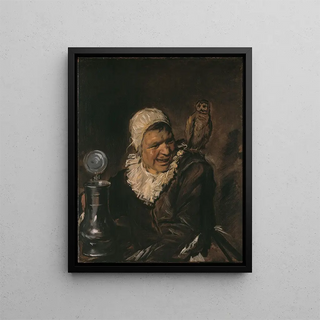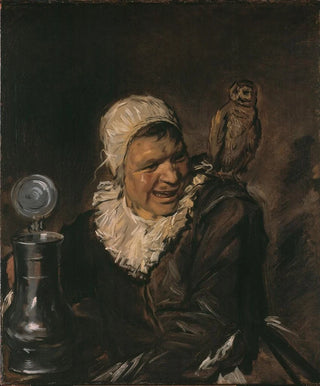Painting Malle Babbe - Frans Hals | Art print


View from behind

Frame (optional)
In the world of art, some works transcend time and continue to evoke deep emotions and reflections on the human condition. "Malle Babbe" by Frans Hals is one of those masterpieces that capture the very essence of life in the 17th century. This canvas, depicting a woman with sparkling eyes, is an open window into an era where painting reflected social mores and intrigues. With her enigmatic smile and nonchalant attitude, Malle Babbe embodies a fascinating figure of Dutch society, oscillating between lightness and depth. The artwork invites exploration of themes of conviviality and intoxication, while offering a reflection on the fleeting beauty of existence.
Style and uniqueness of the work
Frans Hals's style is distinguished by its liveliness and bold approach to portraiture. Unlike other artists of his time, Hals favors a spontaneous and dynamic rendering, capturing not only the physical features of his subjects but also their personality. In "Malle Babbe," the artist uses expressive brushstrokes and vibrant colors to bring this iconic figure to life. Light plays a crucial role in the composition, illuminating the face of the protagonist and creating a striking contrast with the dark background. This chiaroscuro technique gives the artwork emotional depth, while Malle Babbe's expression, both joyful and melancholic, hints at the complexities of the human soul. Every detail, from the extravagant hat to carefully chosen accessories, contributes to the visual storytelling, transforming the painting into a lively scene where the story unfolds before our eyes.
The artist and his influence
Frans Hals, born in Antwerp in 1582, is one of the masters of Dutch portraiture and a pioneer of realism. His work is part of the Baroque movement but stands out for a freer, less conventional approach than that of his contemporaries. Hals was able to capture the essence of his subjects in a way that gives them an almost tangible presence. His influence on future generations of artists is undeniable. Artists like É

Matte finish

View from behind

Frame (optional)
In the world of art, some works transcend time and continue to evoke deep emotions and reflections on the human condition. "Malle Babbe" by Frans Hals is one of those masterpieces that capture the very essence of life in the 17th century. This canvas, depicting a woman with sparkling eyes, is an open window into an era where painting reflected social mores and intrigues. With her enigmatic smile and nonchalant attitude, Malle Babbe embodies a fascinating figure of Dutch society, oscillating between lightness and depth. The artwork invites exploration of themes of conviviality and intoxication, while offering a reflection on the fleeting beauty of existence.
Style and uniqueness of the work
Frans Hals's style is distinguished by its liveliness and bold approach to portraiture. Unlike other artists of his time, Hals favors a spontaneous and dynamic rendering, capturing not only the physical features of his subjects but also their personality. In "Malle Babbe," the artist uses expressive brushstrokes and vibrant colors to bring this iconic figure to life. Light plays a crucial role in the composition, illuminating the face of the protagonist and creating a striking contrast with the dark background. This chiaroscuro technique gives the artwork emotional depth, while Malle Babbe's expression, both joyful and melancholic, hints at the complexities of the human soul. Every detail, from the extravagant hat to carefully chosen accessories, contributes to the visual storytelling, transforming the painting into a lively scene where the story unfolds before our eyes.
The artist and his influence
Frans Hals, born in Antwerp in 1582, is one of the masters of Dutch portraiture and a pioneer of realism. His work is part of the Baroque movement but stands out for a freer, less conventional approach than that of his contemporaries. Hals was able to capture the essence of his subjects in a way that gives them an almost tangible presence. His influence on future generations of artists is undeniable. Artists like É
12,34 €






